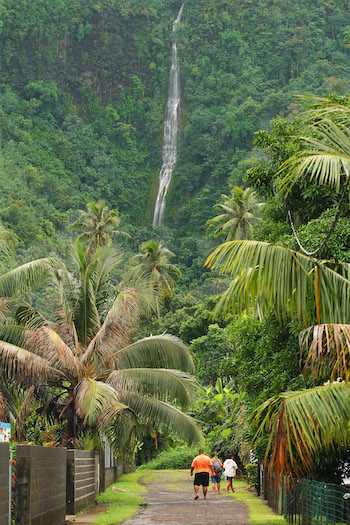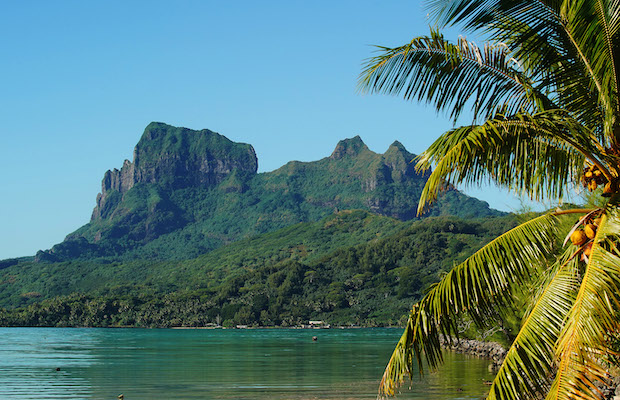French Polynesia Growing Rapidly in Spirituality and Education
Contributed By Aubrey Eyre, Church News staff writer

Kids play on swings as the sun sets in Bora Bora on May 27, 2019.
Article Highlights
- Tahitian members stand as examples of service in the Church.
- The temple is well known in French Polynesia and aids in missionary work.
- Church initiatives have helped Tahitians become more self-reliant.
“The temple is a visual reminder of what the gospel can bring to families, and French Polynesians are very visual.”—President Steven Fox, president of the Tahiti Papeete Mission
Related Links
With stunning blue ocean lagoons nestled below the dense greenery of the forests crawling up the volcanic hills of the islands scattered across the South Pacific, French Polynesia provides a warm and inviting tourist destination. But even for tourists, it’s not just the beautiful scenery that leaves an impression.
“We’re blessed with abundance from nature both on land and in the ocean,” said Manea Tuahu, a Tahitian member of The Church of Jesus Christ of Latter-day Saints. “But more than the beauty of nature, it is the kindness, warmth, and generosity of the people who live here that visitors remember the most.”
Much like other Pacific Islanders from Tonga, Samoa, and New Zealand, the people of French Polynesia are a peaceful and believing people, Tuahu said.
“They are a people of faith,” he said, adding, “I believe it is not coincidence that we were blessed to receive the message of the restored gospel very early on in the history of the Church.”
In a simple yet powerful way, members in French Polynesia act on faith, Tuahu said. “They need little to be happy. They are humble and generous, and they love the Lord and the leaders of the Church.”
Early Beginnings and a Continuing Legacy
When missionaries sent by the Prophet Joseph Smith first landed on the island of Tubuai 175 years ago, in April 1844, they established the first non-English-speaking mission of the Church. Three months later, on July 28, 1844, a branch was established on Tubuai, marking the first official congregation of the Church in French Polynesia.
Sister Kathleen Perrin, matron of the Papeete Tahiti Temple and author of a book detailing the history of the Church in the islands, said adjusting to life on the islands was difficult for the early missionaries. But being warmly welcomed by the people made the transition easier.
Island life can be isolating, Sister Perrin said, noting that her own first experience living on the island of Tubuai was a difficult adjustment. When she first moved there with her husband, in 1977, they stayed only a short time so her husband could do research for a doctorate in international educational development from Columbia University.
“I felt lonely and isolated, but I was overwhelmed by the generosity of the Latter-day Saints of Tubuai, who provided for our physical needs,” she said.
Since that time, the Perrins have lived on various islands throughout French Polynesia for both work and Church callings, and although neither is from French Polynesia originally, they both consider the islands their home now.
“We are Tahitians at heart, coming home for a brief moment,” she said of their current calling as temple president and matron.
Much like their legacy of generosity, the long history of the Church in the islands is something that French Polynesian members are proud to celebrate.
This year, to celebrate the hallmark anniversary of the Church, members in Tahiti showcased the beauty, generosity, and kindness the islands are known for with a large cultural celebration that corresponded with the visit of President Russell M. Nelson to the South Pacific in April.
And today, with a temple located on the island of Tahiti and a steadily increasing membership, the Church is a respected force for good throughout the South Pacific and French Polynesia.
Even Edouard Fritch, the president of French Polynesia, has in recent accounts shared his great admiration for the Church and their missionary efforts throughout his country and the world.
Earlier this year, following a visit from President Russell M. Nelson to Tahiti, President Steven Fox, president of the Tahiti Papeete Mission, had the opportunity to meet with President Fritch and discuss missionary work.
“He said he wishes he had something similar in his church—an opportunity for young people to get out and be dedicated in serving the community and doing good. He said it’s a great way to turn these boys and girls into men and women and great citizens in the country,” President Fox said.

A couple watch the setting sun in Bora Bora on May 28, 2019. Photo by Jeffrey D. Allred, Deseret News.
Love without Expectation
For Rachel Guidi, a native Tahitian who now lives in New Caledonia with her husband, Georgie Guidi, the people of French Polynesia, particularly members of the Church, are examples of what it means to love and serve as Christ did.
Nearly 14 years ago, returning to Tahiti after getting married and being away from the island for many years, the Guidis felt as though they were starting their lives over from ground zero.
“It was hard to find some work,” Rachel Guidi said, explaining that the job her husband had initially been offered had been given away to someone else by the time they arrived back on the island. “So we were there with our two kids with no job and no money,” she said.
Even though they had no money to feed their children and were uncertain of how to continue on without a job, Georgie Guidi told his wife he wanted to show the Lord that they were willing to pay their tithing. So they got a tithing slip and filled it out, indicating that they had nothing to give, and submitted it.
Shortly after that, a Tahitian member whom Rachel Guidi had known in her youth on the island pulled up to their house and opened the trunk of his car, which was filled with an abundance of food storage.
“They just opened the trunk and said, ‘This is for you.’ They arrived with so much love,” Rachel recalled, emotion straining her voice. The man, who turned out to be a member of their bishopric, and his wife were an answer to their prayers and provided just what they needed to get them through that difficult time, she said.
But later, when the Guidis asked the man what they could do to reimburse him for his generosity, the man simply said, “The next time you see someone who needs help, just help them as we helped you. That’s all we ask.”
That is how Tahitians are, Rachel Guidi said. “They give and they share the love without expecting anything in return.”

Voahina Alvarez gets a kiss and a flower for Mother’s Day from Mataunui Vasthi at The Church of Jesus Christ of Latter-day Saints in Papeete, Tahiti, on May 26, 2019. Photo by Jeffrey D. Allred, Deseret News.
Building Faith and Facing Challenges
Of the more than 280,000 people who live in French Polynesia, nearly 70 percent of the population lives on the island of Tahiti, nestled on the northwest side of the island, in Papeete. The rest of the population is spread throughout the five island groups—the Society Islands, the Austral Islands, the Tuamotu Archipelago, the Gambier Islands, and the Marquesas Islands—and formed from some 120 islands.
“One of our challenges here is our isolation,” said Sister Perrin. “The Tahiti temple, for example, is the most isolated temple in the world—meaning that it is farther from another Latter-day Saint temple than any other temple in the world.”
Additionally, for many years, before a university was established in Tahiti by the French government, there were very few possibilities for people to receive an education past high school, Sister Perrin explained.
In many ways, the Church has aimed to help the islands overcome these challenges by implementing programs and even operating primary schools in past years. But even with better access to higher education available both on the islands and elsewhere—through the university, opportunities provided by the French government, and the addition of online schools like BYU–Pathway Worldwide—it can still be a challenge for the rising generation to get a good education, as culturally education is not always viewed as a priority.
“We’re so blessed by mother nature that it’s easy to just be content to live the ‘island life,’ thinking that nature will provide,” Tuahu said. And while that perspective is less common in today’s world, it does present a cultural divide among the generations.
As the impetus among youth to seek education through French and English school systems has increased, there has been a decreased use and knowledge of Tahitian.
“This has created a generational conflict in families, as the traditional Tahitians fight to hold on to their culture and as young Tahitians strive to create better opportunities for their future,” Sister Perrin said.
Within the Church, however, some programs have proven to help generations across the board, especially when it comes to increasing and strengthening their faith.

Roopinia Hilowea teaches Latter-day Saint seminary in Bora Bora on May 28, 2019. Photo by Jeffrey D. Allred, Deseret News.
“The self-reliance initiative has been widely accepted here. All 10 stakes of French Polynesia have self-reliance groups running, with very positive results,” Tuahu said.
Results for participants in the self-reliance program have varied, Tuahu noted, but in many cases, the Church programs have helped members find jobs and even start small businesses.

Picard Vaiora waits outside after meetings at The Church of Jesus Christ of Latter-day Saints in Papeete, Tahiti, on May 26, 2019. Photo by Jeffrey D. Allred, Deseret News.
“But by far, what participants have reported as the biggest outcome from these groups was their spiritual growth,” Tuahu said.
Sharing his own experience as a young adult living in Tahiti, Narri Mitch Pou said, “Having the gospel in my life helped me to have a purpose in life and try to fight for that purpose. I think programs like self-reliance and FSY, they have really helped me build my testimony, and the fact that they always give us responsibilities and callings to keep us busy helps us live a high standard of life.”
As members of the Church continually strive to better themselves, many of the members in Tahiti have participated in every self-reliance course available, and with the addition of programs like BYU-Pathway’s PathwayConnect program, many members are searching for more ways to grow spiritually and temporally for themselves and their future generations.
“One grandmother participated in the PathwayConnect program just to show her grandchildren a good example and to teach them that education is important and that you can always learn,” Tuahu said.

Mau Isabelle Johnston holds her daughter May Kohana after meetings at The Church of Jesus Christ of Latter-day Saints in Papeete, Tahiti, on May 26, 2019. Photo by Jeffrey D. Allred, Deseret News.
Temple Blessings and the Rising Generation
Since it was completed in 1983, the Papeete Tahiti Temple has been widely considered as one of the most beautiful and iconic buildings on the islands.
“[Those of other faiths] know where the temple is, and they want to go in,” President Fox said. “It’s a great missionary tool for us to reference the temple because it really grounds people in what we preach, which is eternal joy by going to the temple and creating families for eternity. So the temple is a visual reminder of what the gospel can bring to families, and French Polynesians are very visual.”
“It’s a proud, humble feeling to have our own temple,” said Elder Benjamin Sinjoux, an Area Seventy and French Polynesian. It is a symbol of Heavenly Father’s love for the people in the South Pacific, he said, noting how members in French Polynesia work hard to accomplish temple work for their ancestors.
As a child, Elder Sinjoux and his parents and siblings were part of the first temple trip for members from Tahiti. In 1963, with a large group of members from the island, their family traveled to Hamilton, New Zealand, to be sealed in the temple. Several years later, in 1975, Elder Sinjoux returned to the New Zealand temple to be sealed to his wife.

Men walk on a street as a waterfall flows near Papeete, Tahiti, on May 26, 2019. Photo by Jeffrey D. Allred, Deseret News.
“Those sealing ordinances remain the highlights of our belonging to the Church,” he said.
Sharing a small personal example of how having a temple in Tahiti has continued to bless his family, Elder Sinjoux described how in early July this year, his son, who serves as a bishop in Tahiti, organized a ward temple trip in which the members did the ordinance work for more than 150 of their ancestors. “It was such a great and overwhelming feeling of peace and joy,” he said of the experience.
Sister Perrin, who currently serves as matron of the Tahiti temple, described the change she has seen since the islands received their own temple.
Prior to the temple, she said, much of the Church leadership in French Polynesia came from foreign mission presidents and foreign missionaries. But just a few years after the temple was built, she was astonished to see how local leadership in the Church had increased.
In 2018, the Church in French Polynesia celebrated the creation of its 10th stake when the Bora Bora Tahiti Stake was organized on April 29. It was an exciting occasion, Elder Sinjoux said, adding that he hopes many more stakes will be created over the coming years as the Church continues to spread and bless the lives of the people.
Another aspect which can be credited for the Church’s growth so far in the 21st century throughout the islands is the CES seminary and institute programs, Sister Perrin said. Those programs “opened up gospel teaching to the young members throughout French Polynesia and created an entire generation of young Latter-day Saints who knew the gospel and were equipped to serve as full-time missionaries and later as local leaders,” she said.
And with more young missionaries being called to serve from the islands outside of French Polynesia, she said it is exciting to witness “another generation of members who have had international experiences and who return to Tahiti with an expanded world view and greater skills to advance the cause of Zion here.”
The youth of the islands, much like youth around the world, face many challenges, Elder Sinjoux said. “We just need to help them as much as we can by strengthening their faith and helping them face issues. But there’s great hope in the rising generation, and with them, the Church will be in good hands.”

Clouds cover the mountains near Papeete, Tahiti, on May 26, 2019. Photo by Jeffrey D. Allred, Deseret News.

The Church of Jesus Christ of Latter-day Saints young women pose with leaders in Papeete, Tahiti, on May 26, 2019. Photo by Jeffrey D. Allred, Deseret News.

Members walk between meetings at The Church of Jesus Christ of Latter-day Saints in Papeete, Tahiti, on May 26, 2019. Photo by Jeffrey D. Allred, Deseret News.

A waterfall flows through the trees near Papeete, Tahiti, on May 26, 2019. Photo by Jeffrey D. Allred, Deseret News.

Members walk between meetings at The Church of Jesus Christ of Latter-day Saints in Papeete, Tahiti, on May 26, 2019. Photo by Jeffrey D. Allred, Deseret News.

A boat is anchored as the sun sets in Bora Bora on May 28, 2019. Photo by Jeffrey D. Allred, Deseret News.

Overwater bungalows are silhouetted in Bora Bora on May 28, 2019. Photo by Jeffrey D. Allred, Deseret News.

Desiree Tetuanui and Hauhere Nauta read scriptures during Latter-day Saint seminary in Bora Bora on May 28, 2019. Photo by Jeffrey D. Allred, Deseret News.

Teharuru Teriipaia and Heraiti Ariiveheata read scriptures during Latter-day Saint seminary in Bora Bora on May 28, 2019. Photo by Jeffrey D. Allred, Deseret News.

A boy plays with a soccer ball near the beach in Bora Bora on May 27, 2019. Photo by Jeffrey D. Allred, Deseret News.

The sun rises on Bora Bora on May 29, 2019. Photo by Jeffrey D. Allred, Deseret News.

Rain and clouds cover the bay in Bora Bora on May 27, 2019. Photo by Jeffrey D. Allred, Deseret News.
